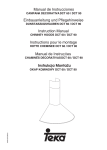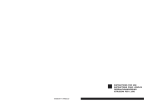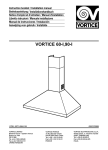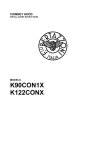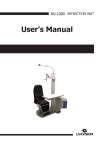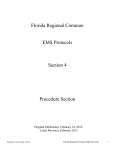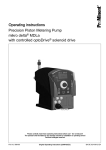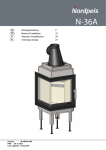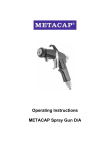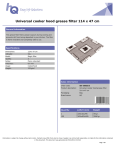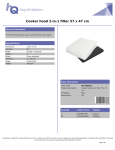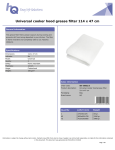Download Teka DCT60 User's Manual
Transcript
Manual de Instrucciones CAMPANA DECORATIVA DCT 60 / DCT 90 Einbauanleitung und Pflegehinweise DUNSTABZUGSHAUBEN DCT 60 / DCT 90 Instruction Manual CHIMNEY HOODS DCT 60 / DCT 90 Instructions pour le montage HOTTE CHEMINEE DCT 60 / DCT 90 Manual de InstruÇÕes CHAMINÉS DECORATIVAS DCT 60 / DCT 90 10401257250/01 OKAP KOMINOWY DCT 60 / DCT 90 2 FIG. 1 FIG. 2 FIG. 3 1 2 MONTAJE SIN SOPORTE BEFESTIGUNG OHNE BEFESTIGUNGSBÜGEL INSTALLATION WITHOUT BRACKET MONTAGE SANS BARRE MONTAGEM SEM SUPORTE MONTA¯ BEZ WSPORNIKA E D E G SOPORTE DE SUJECIÓN DE LOS TUBOS BEFESTIGUNGSBÜGEL FÜR DIE SCHÄCHTE TUBES FIXING BRACKET BARRE DE FIXATION TUBES SUPORTE DE FIXAÇÃO DOS TUBOS WSPORNIK DO MOCOWANIA PRZEWODÓW RUROWYCH G F FIG. 4 FIG. 5 ORIFICIOS PARA COLGAR LA CAMPANA BEFESTIGUNGSLÖCHER FÜR DIE HAUBE HOLES FOR THE HOOD-FIXING TROUS POUR ACCROCHER LA HOTTE FUROSPARA PENDURAR A COIFA OTWORY DO ZAWIESZANIA OKAPU I MIN. 650 ORIFICIOS DE SUJECIÓN DE LA CAMPANA Ø 8 mm SICHERUNGSLÖCHER Ø 8 mm FÜR DIE HAUBE HOOD FIXING HOLES DIAMETER 8mm TROUS DE PERCAGE POUR LA HOTTE DIAM 8mm FUROS DE FIXAÇÃO DE 8 mm DE DIÂMETRO OTWORY DO MOCOWANIA OKAPU Ø 8 mm L M C N R H P GB Introduction PLEASE READ ALL INSTRUCTIONS CAREFULLY BEFORE COMMENCING INSTALLATION. CHECK THAT THE ELECTRICAL SUPPLY DATA QUOTED ON THE RATING PLATE OF THE APPLIANCE AGREES WITH THAT OF YOUR SUPPLY. (SEE NOTE “SAFETY REQUIREMENTS”) These instructions are designed to tell you of the various technical details of your cooker hood and to make you familiar with its use. Since these instructions cover more than one type of the hood within the same series, it may be that reference is made to components that do not form part of the hood that you are installing. The hood may be used as an exhaust or filter hood. If evacuation is available (exhaust duct or air flue) we recommend using the hood in the exhaust version to discharge all the kitchen vapors and odors outdoors. Suggestions for using the hood in exhaust position When an exhaust hood and a heat source requiring ambient air (e.g. gas, oil, coal stoves, etc.) are used at the same time, attention is required because the air necessary for combustion is exhausted from the room through the hood and this creates depression. There is no such danger when the maximum depression in the room is 0,04mbar. In this condition no exhaust gas from the heat source is piped. To assure this condition, make openings in the room which cannot be closed (doors, windows, etc. are not sufficient) and through which the air necessary for combustion can freely flow. Note: All the exhaust ductwork in the apartment or house should be studied. In case of doubts, get advise or authorization from the person or agency responsible for the building. When using gas burners, gas ovens, etc. as well as when using the hood in the filter version, these precautions are not necessary. Note: The efficiency of the exhaust hood decreases as the length of the ducts and number of elbows increase. When using the exhaust version, follow these rules: Do not connect the exhaust hood to chimney, flues, and air ducts serving the room. Before venting into exhaust flues and ducts no longer in use, ask for the approval of the person or agency responsible for the building. The evacuated air must not be let into a warm air duct. For the evacuation of the exhausted air please note ufficial instructions. Installation The hood must be mounted over the centre of the cooking area. The minimum distances between the cooking area and the underpart of the hood are 650 mm. Warning: If the room contains a flued fuel burning appliance which is not of the “balance flue” type make sure these is an adequate air inlet to the room at all times so that fumes are not drawn down the flue. N.B. The distances, however, are subject to the safety rules in effect in the various countries. Before drilling the wall make sure that no pipes or cables will be damaged. If there is no outer waste-pipe for the exhaust version, an air outlet with a diameter of Ø160mm, in case you use the spigot reduction (pict.5/C) you need an exhaust outlet of 130mm. Attention: Take attention that the wall will support the weight of the cookerhood (about 30 Kg). The screws supplied with this rangehood are designed for fixing to reinforced concrete, masonry walls or hollow building blocks. Installation without bracket 1) Set the distance between the cooker hob and the hood (pict. 4). 2) Fix the two screws and the two upper plugs into the wall at the height previously chosen (pict. 5). 3) Hang the hood to the wall checking that the screw (pict. 5/P) correctly fits into the hole (pict. 5/R). 4) In order to provide an exact installation the cooker hood (in the rear of the body) is supplied with two holes of 8 mm diameter, where the two screws with plugs have to be inserted. Insure that all parts are properly fixed and that it is impossible to touch moving parts. Connection filtering /exhaust 1) In the exhaust version link a 125 mm diameter air outlet chimney to the spigot (pict. 5/M). This pipe is not supplied with the hood. 2) If the filtering connection (pict. 5/N) is made of steel fix it onto the hood outlet by means of the three screws supplied. Installation of the pipes (valid for exhaust or filter version) 1) Fix the bracket (pict. 5/D) with 2 plugs and screws (pict. 5/E) in the required high for the pipe. 2) Screw the short pipe (pict. 5/F) with 2 screws on the bracket (pict. 5/ G). 3) Put the long pipe over the short one (pict. 5/I) by pulling a part the laterals of the pipe. 4) Fix the long chimney from the outside (pict. 5/L) by using two screws which must be inserted into the holes at the foot of the chimney (pict. 5/H). Electric connection Make sure the supply voltage ratings correspond with those stated on the appliance data plate. Attention: if the appliance is not provided with a plug or cannot be easily connected to a wall socket, then the electrical circuit must incorporate a circuit breaker having at least a 3 mm separation between contacts. If the appliance is provided with a supply cord and plug, the appliances must be positioned so that the plug is accessible. Attention: the electrical supply cable must be connected as follow: Green/Yellow=ground — Blue = neutral — Brown = line Important: the hood manufacturer will not be responsible for any damage or loss caused by failure to observe these instructions. Important: a damaged power supply cord must be replaced by the service. Operating instructions The cooker hood should be switched on either before or at the same as cooking or frying commences. The grease and carbon filters are more effective if the fan is not switched off immediately after cooking or frying is completed, but only after a period of some 20-30 minutes. Before using the cooker hood please ensure that all plastic films like on metal grease filter an stainless steel ducting are removed. User instructions Working instruction of the cooker hood Mechanical Switches (Pict.3) (slide or pushbutton) 1 - Speed Switch 2 - Light Switch Lamp Replacement To changes a incandescent bulbs please work from outside of the hood means to pull off the lamp diffuser. Never use lamps with a wattage higher than the one shown on the label inside the hood. Safety rules Do not do any flambé cooking underneath the hood. When frying, never leave the pan alone because the cooking oil could flare up. Clean all the surfaces frequently to avoid danger of fire. This can be done with a cloth or/ and with a brush drenched with denatured alcohol or with any other similar. It is also important to remove and clean or substitute frequently the filter installed in the hood. This appliance is not intended for use by small children or infirm persons without supervision. Young children should be supervised to ensure that they do not play with the appliance. Maintenance NOTE: Prior to any maintenance, switch off and disconnect from electrical supply. 1) Under normal cooking conditions the grease filter should be cleaned every 10-15 days in hot water, to which a suitable detergent has been added. For reasons of efficiency and safety regular cleaning is advised. The grease filter may be subject to a small amount of shrinkage initially. 2) The outer casing of the Cooker Hood should be cleaned with a damp cloth. 3) The effective life of the carbon filter will naturally depend on the frequency and type of cooking fumes to which it is subject. As general guide we suggest that a replacement is fitted at least every 12 months. 4) Once a year, (more frequently with heavy usage), call a serviceman to clean the fan and air ducts to prevent build-up of flammable fat deposits. The carbon filter When a carbon filter is fitted, the air that is sucked in is additionally cleaned by the active carbon particles within the filter. This filter cannot be cleaned and so needs to be replaced from time to time, approximately every six months, depending on how frequently the hood is in use. Replacing the active carbon filter (only for recirculation hoods) The filter can be easily removed it is sufficient to rotate it anticlockwise (pict. 2). Grease filter This absorbs vapour-suspended grease particles and protects the kitchen and furniture from greasy residues. The filter should be washed every 10 to 15 days (in normal operating conditions). Dip the filter into a de-greaser solution or put it in the dish washer. Make sure not to damage the filter, which is made of several layers of thin alloy, by hitting or crushing it. The aluminium filter will may change colour, that will have no influence of the efficiency of the filter, may it will improve it. Replacing or cleaning the filters To remove the aluminium grease filter (pict.1), grab the opening tongue at the filter, pull it in your direction and move the filter downwards. To reinstall it operate reversed. Safety Requirements Exhaust air must not be discharged into any chimney, or flue which may carry combustion products from other sources. In addition, exhaust air must not be discharged into a wall cavity unless designed for the purpose. Note instructions for cleaning fan as note “4” on “MAINTENANCE”. Moreover it is important to clean regularly each filter of the hood or replace it. N.B. THE RANGEHOOD IS DESIGNED FOR INDOOR USE ONLY. UNDER NO CIRCUMSTANCES SHOULD THIS UNIT BE INSTALLED IN OUTDOOR CONDITION OR OVER A BARBECUE.




